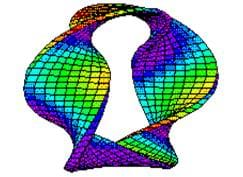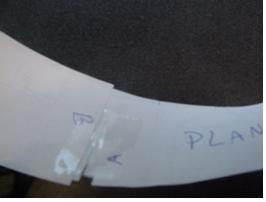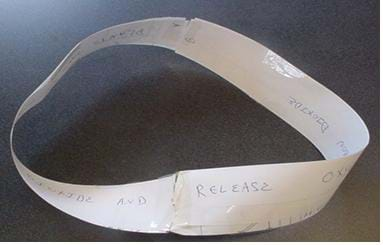Quick Look
Grade Level: 4 (3-5)
Time Required: 30 minutes
Expendable Cost/Group: US $0.25
Group Size: 1
Activity Dependency: None
NGSS Performance Expectations:

| 5-LS2-1 |
Summary
Students make Moebius strips and use them to demonstrate the interconnectedness of an environment. They explore four natural cycles — water, oxygen/carbon dioxide, carbon, nitrogen — that exist within the environment.
Engineering Connection
It is incredibly important for environmental engineers to be familiar with the water cycle, oxygen/carbon dioxide cycle, carbon cycle and nitrogen cycle as they make decisions that ensure that environments are safe for its inhabitants. Environmental engineers use their knowledge of the abiotic (non-living) parts of our environment to design systems that provide us with clean water to drink, safe air to breathe and natural resources that are protected for future generations.
Learning Objectives
After this activity, students should be able to:
- Describe the water, oxygen/carbon dioxide, carbon and nitrogen cycles.
- Describe how cycles are connected within an environment.
- Understand why engineers need to know about environmental cycles.
Educational Standards
Each TeachEngineering lesson or activity is correlated to one or more K-12 science,
technology, engineering or math (STEM) educational standards.
All 100,000+ K-12 STEM standards covered in TeachEngineering are collected, maintained and packaged by the Achievement Standards Network (ASN),
a project of D2L (www.achievementstandards.org).
In the ASN, standards are hierarchically structured: first by source; e.g., by state; within source by type; e.g., science or mathematics;
within type by subtype, then by grade, etc.
Each TeachEngineering lesson or activity is correlated to one or more K-12 science, technology, engineering or math (STEM) educational standards.
All 100,000+ K-12 STEM standards covered in TeachEngineering are collected, maintained and packaged by the Achievement Standards Network (ASN), a project of D2L (www.achievementstandards.org).
In the ASN, standards are hierarchically structured: first by source; e.g., by state; within source by type; e.g., science or mathematics; within type by subtype, then by grade, etc.
NGSS: Next Generation Science Standards - Science
| NGSS Performance Expectation | ||
|---|---|---|
|
5-LS2-1. Develop a model to describe the movement of matter among plants, animals, decomposers, and the environment. (Grade 5) Do you agree with this alignment? |
||
| Click to view other curriculum aligned to this Performance Expectation | ||
| This activity focuses on the following Three Dimensional Learning aspects of NGSS: | ||
| Science & Engineering Practices | Disciplinary Core Ideas | Crosscutting Concepts |
| Develop a model to describe phenomena. Alignment agreement: Science explanations describe the mechanisms for natural events.Alignment agreement: | The food of almost any kind of animal can be traced back to plants. Organisms are related in food webs in which some animals eat plants for food and other animals eat the animals that eat plants. Some organisms, such as fungi and bacteria, break down dead organisms (both plants or plants parts and animals) and therefore operate as "decomposers." Decomposition eventually restores (recycles) some materials back to the soil. Organisms can survive only in environments in which their particular needs are met. A healthy ecosystem is one in which multiple species of different types are each able to meet their needs in a relatively stable web of life. Newly introduced species can damage the balance of an ecosystem. Alignment agreement: Matter cycles between the air and soil and among plants, animals, and microbes as these organisms live and die. Organisms obtain gases, and water, from the environment, and release waste matter (gas, liquid, or solid) back into the environment.Alignment agreement: | A system can be described in terms of its components and their interactions. Alignment agreement: |
International Technology and Engineering Educators Association - Technology
-
Explain how various relationships can exist between technology and engineering and other content areas.
(Grades
3 -
5)
More Details
Do you agree with this alignment?
State Standards
Colorado - Science
-
Create and evaluate models of the flow of nonliving components or resources through an ecosystem
(Grade
4)
More Details
Do you agree with this alignment?
Materials List
Each student should have:
- Four 2' strips of approximately 2" wide adding machine tape (available at office supply stores)
- Four 2" pieces of transparent tape
- Four 1" pieces of masking tape
Worksheets and Attachments
Visit [www.teachengineering.org/activities/view/cub_environ_lesson01_activity2] to print or download.Introduction/Motivation
In 1858, a German mathematician named August Ferdinand Moebius came upon a loop of paper with a truly astonishing property: it had only one side. This strip later became known as the Moebius strip. Such an unusual loop can be used to demonstrate how the abiotic components of an environment are recycled (used again and again) in processes including the water cycle, the oxygen/carbon dioxide cycle, the carbon cycle and the nitrogen cycle.
Have you ever heard of one of these cycles? For example, do you know that oxygen is breathed in by animals and then breathed out as carbon dioxide? Then in turn, plants take in that same carbon dioxide and then release oxygen for those same (and many other) animals to breathe in again? This is an example of a cycle in nature — the oxygen cycle. Another example of a cycle in nature is the water cycle. Have you ever thought about water being a cycle? Think about how the water from a lake evaporates into the sky and later comes back down to the lake in the form of rain or precipitation. Is that a cycle? Yes, it is; that's part of the water cycle. Nitrogen and carbon have similar cycles. All cycles are important abiotic (non-living) parts of nature. Most every biotic (living) part of nature needs all these abiotic cycles to exist. There are so many connections in nature!
Why do you think environmental engineers need to know about these cycles? Any guesses? Well, environmental engineers work with all of these cycles to help us maintain a safe environment in which to live. Engineers need to understand how water, oxygen, nitrogen and carbon cycle through the environment to help clean up pollution and protect the areas in which we live and the air that we breathe. Environmental engineers also use what they learn about these abiotic parts of the environment to design and create technologies to make our water cleaner to drink, the air safer to breathe, and to protect our natural resources so they will be around for a long time into the future.
Today we are going to learn about the abiotic cycles in nature. We are also going to make our own Moebius strips to demonstrate the connections in nature.
(Note: This activity is adapted from: Science is...A source book of fascinating facts, projects, and activities, by Susan V. Bosak.)
Procedure
Before the Lesson
- Cut enough 2' strips of adding machine tape so that each student has four strips.
- Consider pre-labeling the strips with the cycle phases (see steps #4 & #6 in the With the Students section), or use a projector to present the Handout with the cycle phases on it for students to copy onto their strips (presenting a transparency of the Handout with an overhead projector works as well).
- If possible, find pictures of the four environmental cycles (water, oxygen/carbon dioxide, carbon and nitrogen cycles) for students to see and have on hand for the activity.
With the Students
- Review each of the four cycles of nature (water, oxygen/carbon dioxide, carbon, nitrogen). Ask students to share what they already know and then share the pictures you found.
- Distribute 4 strips of adding machine tape and 4 pieces of transparent tape to each student.
- Ask students to label each end of one side of each strip with an "A" and the other ends of the opposite side of each strip with a "B" (see Figure 2, left). In other words, each strip has an A printed on the ends of one side, and a B printed on the ends of the reverse side.

- Ask students to write the words for each phase (see The Four Cycles of Nature handout, attached) of the cycles on side A of the four paper strips, as shown in Figure 2, center and right. Students should write in one long sentence, horizontally on the strip.
- Once done, have the students flip each strip over (i.e., the side B phrases should start at the same end that the side A phrases start, but will end up being written upside down to side A).
- Ask students to write the words for each phase (see The Four Cycles of Nature handout, attached) of the cycles on Side B of the four paper strips, as shown in Figure 2 (center and right), center and right. Students should write in one long sentence, horizontally on the strip.
- Have the students pick one of their A strips to work with first. They should twist the strip a half turn and tape the "A" end to the "B" end. (This is the tricky part and it takes some students awhile to get it.)

- Ask students to find the cycle's starting phrase (at the "A" label) and mark it with an "X." Starting at the "X," draw arrows from word to word.
- The Moebius strip should have no beginning and no end, but just keeps constantly repeating the cycle (see Figure 4).

- Ask students to describe, in their own words, how these strips are related to environments.
- Ask the students to repeat this process for each of their three remaining strips.
Assessment
Pre-Activity Assessment
Discussion Questions: Solicit, integrate and summarize student responses.
- Ask the students if they can think of any cycles in nature. Have they heard about the water cycle, the oxygen/carbon dioxide cycle, the carbon cycle, and the nitrogen cycle?
- What do they know about these four abiotic components of the environment?
Activity Embedded Assessment
Discussion Question: Ask students to describe, in their own words, how the strips are related to environments.
Post-Activity Assessment
Drawing: Fold a piece of paper into fourths (or into half and use both sides of the sheet). Number each section 1 through 4. Have the students draw a picture in each section to illustrate the sentences and cycles on their four Moebius strips. Have them label their drawing or write a sentence describing it in their own words. (An alternative to this exercise is to have each student pick one of the Moebius strips to illustrate.)
Create Your Own Moebius Strip: Ask the students to come up with their own phrases about a cycle in nature (i.e., the Rock cycle) and make new Moebius strips.
Troubleshooting Tips
To save time, label the strips in advance.
Students may need assistance understanding the "twisting" procedure. It is important that students only twist their strips one-half turn each.
Activity Extensions
Demonstrate that each cycle is part of the bigger world ecosystem by cutting the Moebius strip down the center to create one very large loop.
Demonstrate that each cycle is intertwined with the others by making a full twist of the strip before taping the ends together. Then cut the loop down the middle to get two interlinked loops.
Try other twist and cut combinations.
Activity Scaling
- For lower grades, simplify the activity by making and labeling the strips in advance. Or, have students make just one strip, such as for the water cycle, and do the other strips as a class demonstration. Or, have students work in groups of four and give each student a different cycle to make, which gives each student a chance to make one and allows all four cycles to be discussed.
Subscribe
Get the inside scoop on all things TeachEngineering such as new site features, curriculum updates, video releases, and more by signing up for our newsletter!More Curriculum Like This

Students are introduced to the concept of an environment and the interactions within it through written and hands-on webbing activities. They also learn about environmental engineering careers and the roles of these engineers in our society.

Students are introduced to the concept of energy cycles by learning about the carbon cycle. They learn how carbon atoms travel through the geological (ancient) carbon cycle and the biological/physical carbon cycle.

Students learn about energy and nutrient flow in various biosphere climates and environments. They learn about herbivores, carnivores, omnivores, food chains and food webs, seeing the interdependence between producers, consumers and decomposers. This lesson is part of a series of six lessons in whic...

Students are introduced to the fabulous planet on which they live. They learn how engineers study human interactions with the Earth and design technologies and systems to monitor, use and care for our planet's resources wisely to preserve life on Earth.
References
Bosak, Susan V. Science is...: A source book of fascinating facts, projects, and activities, "Strip Tease," Markham, Ontario: Scholastic Canada Ltd., pg. 207, 2000.
Copyright
© 2005 by Regents of the University of Colorado.Contributors
Amy Kolenbrander; Jessica Todd; Malinda Schaefer Zarske; Janet YowellSupporting Program
Integrated Teaching and Learning Program, College of Engineering, University of Colorado BoulderAcknowledgements
The contents of this digital library curriculum were developed under a grant from the Fund for the Improvement of Postsecondary Education (FIPSE), U.S. Department of Education and National Science Foundation GK-12 grant no. 0338326. However, these contents do not necessarily represent the policies of the Department of Education or National Science Foundation, and you should not assume endorsement by the federal government.
Last modified: February 7, 2022









User Comments & Tips